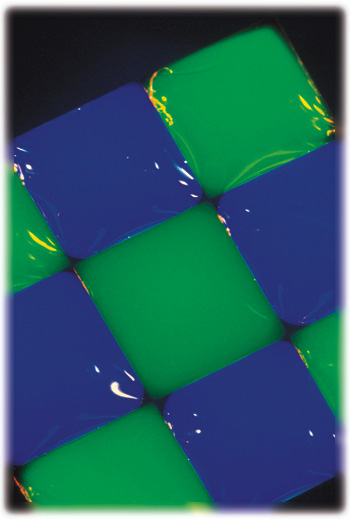![]()
Main Menu ·
Search ·
Current Issue · Contact · Archives · Centennial · Letters to the Editor · FAQs
![]()
Main Menu ·
Search ·
Current Issue · Contact · Archives · Centennial · Letters to the Editor · FAQs

|
To keep sheep, you need fences; unfenced sheep spread, wandering after grass.
These colored squares are drops of water. They rest on a surface across which they would normally form circular drops and spread until they coalesced. Instead, they are performing unnatural acts: forming squares, staying in place, not mixing. What fences pen them? What grass attracts them?
The surface beneath the drops has been coated with a single layer of molecules of a type much loved by water (a hydrophilic surface). The water molecules cover it as completely as they can. But the surface has also been broken into square fields by painted stripes a single molecule thick of a different type of molecule, one the water avoids (a hydrophobic surface). The molecules of water crowd to the edges of these stripes, but they do not jump them.
The backs of sheep are often spray-painted to identify them; the colors show when part of a flock has found a gap in a fence and drifted into another field. Dyes added to these drops do the same for water.
The square drops are approximately 0.4 centimeters across; the stripes dividing them are 1 micron across and one-thousandth of a micron high. If the water molecules were sheep, the fence would be 3 sheep tall and 1,500 sheep across, and the sheep would be piled 1 million deep in the center of the field. It would be a peculiar form of agriculture.
Controlling the spreading of liquids on surfaces--the wetting of the surface by the liquid--is surprisingly important, not only in painting, printing, and gluing, but also in growing mammalian cells; in fabricating the myriad micro-electronic devices that swarm around us in computers, cars, airplanes, and air conditioners; and in condensing steam in boilers.
Main Menu ·
Search · Current Issue · Contact · Archives · Centennial · Letters to the Editor · FAQs
![]()